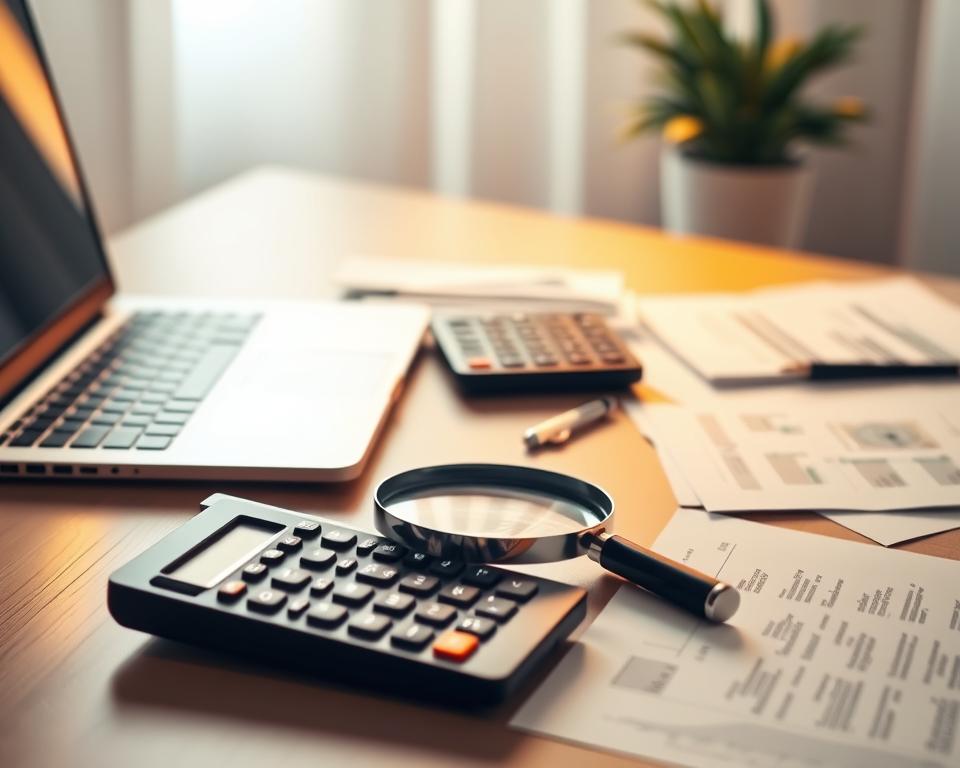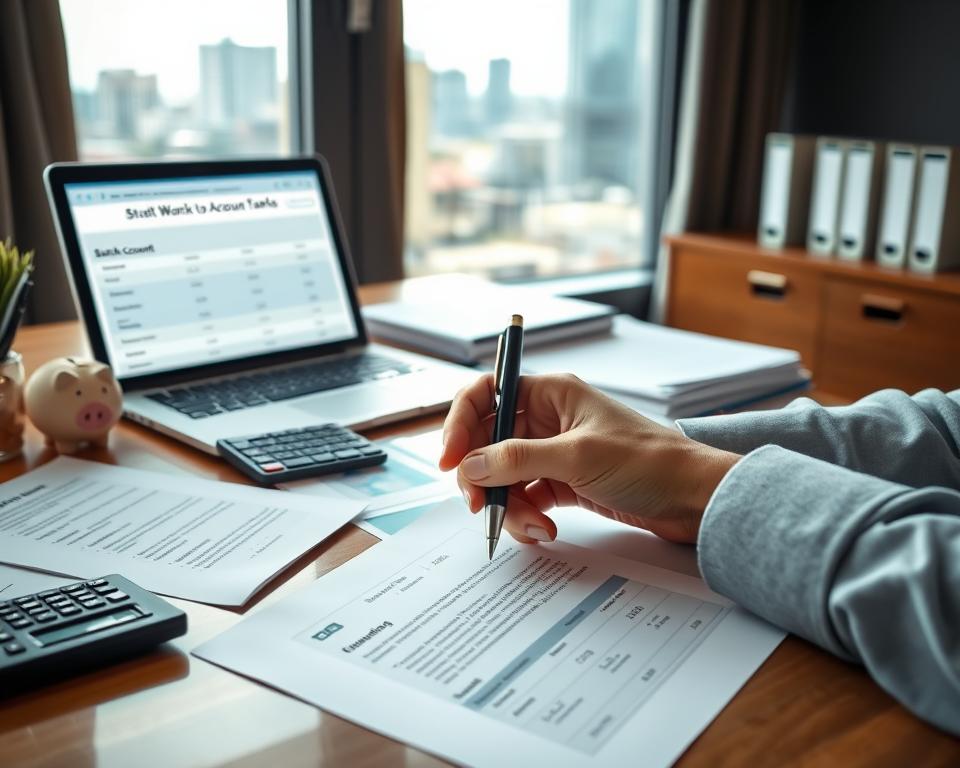Advertisement
Did you know nearly 70% of Americans never switch their primary bank account? This shows a big chance for people to improve their finances. Switching banks can get you better interest rates, lower fees, and cool online services.
If you’re thinking about switching banks, this guide will make it easier. It will help you switch bank accounts smoothly and efficiently.
Considerations Before Switching Banks
Thinking about switching banks? First, do a banking needs assessment. Know what you need from a bank. This could be checking and savings accounts, loans, or special services.
Evaluating Your Current Banking Needs
Think about your current bank’s services. Do they offer mobile banking and good customer service? Knowing what you need helps you choose the right bank.
Benefits and Costs of Different Institutions
Look at what each bank offers and their costs. Make a chart to compare fees, interest rates, and promotions. Think about long-term benefits, not just short-term deals. Also, talk to your current bank about fees to see if they can help.
| Bank Name | Monthly Fees | Interest Rate (Savings) | Mobile Banking Features | Customer Service Rating |
|---|---|---|---|---|
| Chase Bank | $10 | 0.01% | Excellent | 4.5/5 |
| Bank of America | $12 | 0.03% | Very Good | 4/5 |
| Wells Fargo | $15 | 0.02% | Good | 3.5/5 |
| Capital One | $0 | 0.15% | Excellent | 4.7/5 |

Signs It’s Time to Switch Banks
Thinking about switching banks? It’s important to know when it’s time for a change. Look out for signs like bad service or too many fees. These signs can help you choose a better bank.
Understanding Why You May Need to Change
Customers often face problems that make them want to switch banks. Issues like slow transactions, hard-to-reach customer support, or outdated online banking can be frustrating. Poor service can also make you lose trust in your bank.
Assessing Current Fees and Services
Looking at bank fees is key. High fees, low interest rates, and surprise charges can hurt your wallet. A good bank service check can show if you’re getting good value for your money. Knowing how fees affect your finances is important.
| Fee Type | Current Bank | Competitor Bank | Difference |
|---|---|---|---|
| Account Maintenance Fee | $12/month | $5/month | $7/month savings |
| Overdraft Fee | $35/transaction | $25/transaction | $10 savings |
| ATM Fees | $3.00/transaction | $0.00/transaction | $3 savings |

Researching New Bank Options
Thinking about switching banks? It’s important to do your homework. Comparing banks helps you find the right one for you. Look at things like interest rates, fees, and online services.
New features can make a big difference in your banking experience.
Comparing Benefits and Features
Every bank has its own set of benefits. It’s key to find the ones that match your financial style. Think about features like mobile deposit, no ATM fees, or budgeting tools.
Make a list of what you need. This way, you can easily find a bank that fits your needs.
Checking for Promotions and Offers
Keep an eye out for special offers when opening a new account. Some banks might give you cash or waive fees for a year. But, make sure these deals align with your financial plans.
While offers can be tempting, choose a bank that offers good features for the long run.
How to Switch Your Bank Account Easily
Switching your bank account is easy with the right steps. This guide will help you switch banks smoothly. Start by looking for banks that fit your needs. Think about fees, interest rates, and customer service.
After picking a new bank, get your documents ready. You’ll need ID and proof of address. You can open the new account online, making it quick and easy.
Make a list of all your regular payments and direct deposits before switching. This way, you won’t miss any during the change. Once your new account is ready, update these payments. Keep an eye on your old account for any missed transactions.
Talk to both banks during the process to avoid problems. By following these steps, switching banks will be a breeze.
Setting Up Your New Account
After picking a new bank, it’s time to set up your account. This starts with opening bank accounts online, which takes just a few minutes. You’ll need personal info, Social Security numbers, and more to get started.
Opening Your New Bank Account
When opening your account, you’ll see different types to choose from. It’s key to compare these to pick the right one for you. You might look at checking, savings, or money market accounts, based on your financial plans.
Funding Your New Account and Meeting Minimums
After opening your account, you’ll need to fund it. Remember, your bank might have minimum balance requirements. Some banks let you start with as little as $25. Planning your deposit helps keep your account in good shape and avoids fees.
Transferring Direct Deposits and Automatic Payments
After setting up your new bank account, the next step is to move direct deposits and update automatic payments. This needs careful planning and quick communication with your employer and service providers. It’s important to make the transition smooth.
Updating Your Recurring Payments
Start by telling your employer about your new bank account for direct deposits. Then, list all automatic payments from your old account, like bills and subscriptions. Contact each company to give them your new account info.
This way, all payments will go through without a hitch.
Monitoring Transactions During the Transition
While moving your deposits, watch both your old and new accounts closely. Look out for any pending transactions or extra fees. This helps avoid overdrafts or missed payments if a payment tries to take money from the closed account.
With good management, you can handle your financial duties without trouble.
Closing Your Old Bank Account
When you close a bank account, make sure all financial duties are done. It’s important to check for any final transactions. This includes checks or debit card uses that might still be pending.
These checks help avoid problems like overdraft fees or unpaid bills. It’s a step to keep your finances stable during the change.
Before you ask to close your account, look at your recent activities. Check your statements and make sure payments are going to your new bank. This step helps prevent extra fees and keeps your finances secure.
After checking that all transactions are complete and your old debts are paid, you can close your account. This careful planning makes the process smoother. It also protects you from future financial issues.
Security Measures When Switching Accounts
When you switch banks, keeping your account safe is key. You need to handle sensitive info carefully and watch out for scams. This ensures a smooth move to your new bank.
Disposing of Old Checks and Cards Securely
After closing your old account, it’s important to get rid of checks and debit cards safely. Don’t just throw them away. Use a shredder to destroy them. This step keeps your info safe and lets you focus on your new bank.
Avoiding Scams and Fraudulent Institutions
When looking for a new bank, be careful to avoid scams. Check if a bank is real before joining. The FDIC’s BankFind can help you find trusted banks. Be cautious of scams trying to get your info during this time. These steps help you have a safe banking experience.
Adjusting to Your New Banking Experience
Switching banks can make your banking better. Getting used to new banking means learning about online tools from your bank. These tools make it easy to check balances and move money.
Utilizing Online and Mobile Banking Tools
Online banking tools let you access your account anywhere. Most banks have apps for your phone, so you can manage money on the go. Features like mobile check deposit and bill pay save time and make life easier.
Getting Familiar with New Banking Features
Explore all the features your new bank has. They might offer budgeting tools, spending alerts, and savings calculators. Using these tools well can help you spend smarter and save more.
Conclusion
Switching banks can be easy if you plan well. First, figure out what you need from a bank. Then, look for banks that offer what you need.
Knowing what you have now and what new banks offer helps a lot. This way, moving to a new bank can be smooth.
It’s also important to close your old account the right way. This avoids extra fees and makes sure you meet all your financial duties. These tips help you stay on top of things when changing banks.
Finally, keep your money safe when switching banks. Learn about the new bank’s features and tools. This makes adjusting to your new bank better for you.



